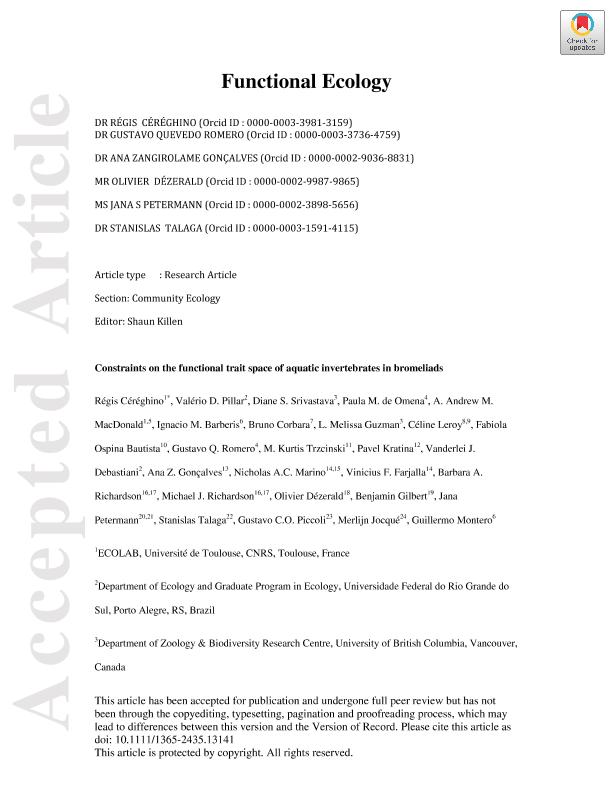Artículo
Constraints on the functional trait space of aquatic invertebrates in bromeliads
Céréghino, Régis; Pillar, Valério D.; Srivastava, Diane S.; de Omena, Paula M.; MacDonald, A. Andrew M.; Barberis, Ignacio Martín ; Corbara, Bruno; Guzmán, Maria Laura; Leroy, Céline; Ospina Bautista, Fabiola; Romero, Gustavo Q.; Trzcinski, M. Kurtis; Kratina, Pavel; Debastiani, Vanderlei J.; Gonçalves, Ana Z.; Marino, Nicholas A. C.; Farjalla, Vinicius F.; Richardson, Barbara A.; Richardson, Michael J.; Dézerald, Olivier; Gilbert, Benjamin; Petermann, Jana; Talaga, Stanislas; Piccoli, Gustavo C. O.; Jocqué, Merlijn; Montero, Guillermo Alberto
; Corbara, Bruno; Guzmán, Maria Laura; Leroy, Céline; Ospina Bautista, Fabiola; Romero, Gustavo Q.; Trzcinski, M. Kurtis; Kratina, Pavel; Debastiani, Vanderlei J.; Gonçalves, Ana Z.; Marino, Nicholas A. C.; Farjalla, Vinicius F.; Richardson, Barbara A.; Richardson, Michael J.; Dézerald, Olivier; Gilbert, Benjamin; Petermann, Jana; Talaga, Stanislas; Piccoli, Gustavo C. O.; Jocqué, Merlijn; Montero, Guillermo Alberto
 ; Corbara, Bruno; Guzmán, Maria Laura; Leroy, Céline; Ospina Bautista, Fabiola; Romero, Gustavo Q.; Trzcinski, M. Kurtis; Kratina, Pavel; Debastiani, Vanderlei J.; Gonçalves, Ana Z.; Marino, Nicholas A. C.; Farjalla, Vinicius F.; Richardson, Barbara A.; Richardson, Michael J.; Dézerald, Olivier; Gilbert, Benjamin; Petermann, Jana; Talaga, Stanislas; Piccoli, Gustavo C. O.; Jocqué, Merlijn; Montero, Guillermo Alberto
; Corbara, Bruno; Guzmán, Maria Laura; Leroy, Céline; Ospina Bautista, Fabiola; Romero, Gustavo Q.; Trzcinski, M. Kurtis; Kratina, Pavel; Debastiani, Vanderlei J.; Gonçalves, Ana Z.; Marino, Nicholas A. C.; Farjalla, Vinicius F.; Richardson, Barbara A.; Richardson, Michael J.; Dézerald, Olivier; Gilbert, Benjamin; Petermann, Jana; Talaga, Stanislas; Piccoli, Gustavo C. O.; Jocqué, Merlijn; Montero, Guillermo Alberto
Fecha de publicación:
10/2018
Editorial:
Wiley Blackwell Publishing, Inc
Revista:
Functional Ecology
ISSN:
0269-8463
e-ISSN:
1365-2435
Idioma:
Inglés
Tipo de recurso:
Artículo publicado
Clasificación temática:
Resumen
Functional traits are commonly used in predictive models that link environmental drivers and community structure to ecosystem functioning. A prerequisite is to identify robust sets of continuous axes of trait variation, and to understand the ecological and evolutionary constraints that result in the functional trait space occupied by interacting species. Despite their diversity and role in ecosystem functioning, little is known of the constraints on the functional trait space of invertebrate biotas of entire biogeographic regions. We examined the ecological strategies and constraints underlying the realized trait space of aquatic invertebrates, using data on 12 functional traits of 852 taxa collected in tank bromeliads from Mexico to Argentina. Principal Component Analysis was used to reduce trait dimensionality to significant axes of trait variation, and the proportion of potential trait space that is actually occupied by all taxa was compared to null model expectations. Permutational Analyses of Variance were used to test whether trait combinations were clade-dependent. The major axes of trait variation represented life-history strategies optimizing resource use and antipredator adaptations. There was evidence for trophic, habitat, defence and life-history niche axes. Bromeliad invertebrates only occupied 16%?23% of the potential space within these dimensions, due to greater concentrations than predicted under uniform or normal distributions. Thus, despite high taxonomic diversity, invertebrates only utilized a small number of successful ecological strategies. Empty areas in trait space represented gaps between major phyla that arose from biological innovations, and trait combinations that are unviable in the bromeliad ecosystem. Only a few phylogenetically distant genera were neighbouring in trait space. Trait combinations aggregated taxa by family and then by order, suggesting that niche conservatism was a widespread mechanism in the diversification of ecological strategies. A plain language summary is available for this article.
Archivos asociados
Licencia
Identificadores
Colecciones
Articulos(IICAR)
Articulos de INST. DE INVESTIGACIONES EN CIENCIAS AGRARIAS DE ROSARIO
Articulos de INST. DE INVESTIGACIONES EN CIENCIAS AGRARIAS DE ROSARIO
Citación
Céréghino, Régis; Pillar, Valério D.; Srivastava, Diane S.; de Omena, Paula M.; MacDonald, A. Andrew M.; et al.; Constraints on the functional trait space of aquatic invertebrates in bromeliads; Wiley Blackwell Publishing, Inc; Functional Ecology; 32; 10; 10-2018; 2435-2447
Compartir
Altmétricas



